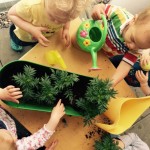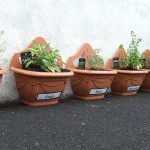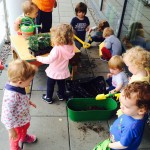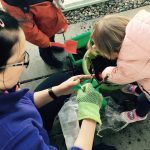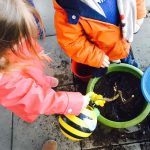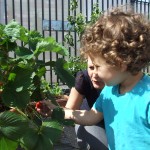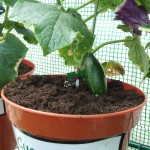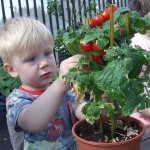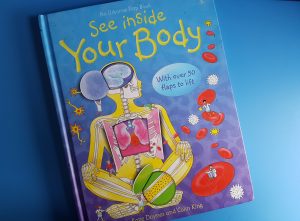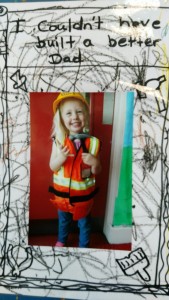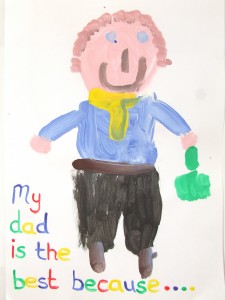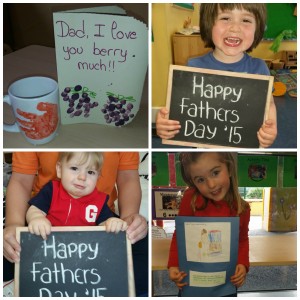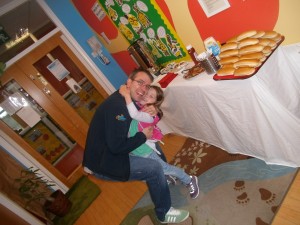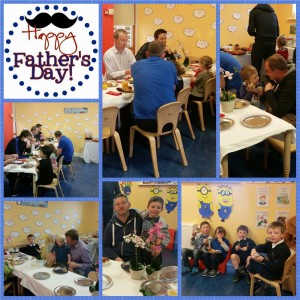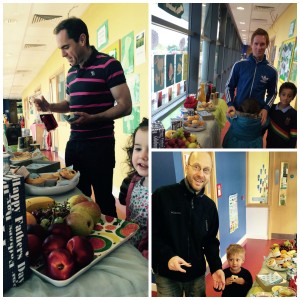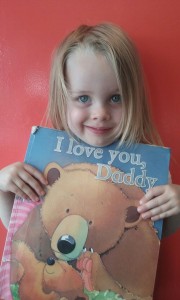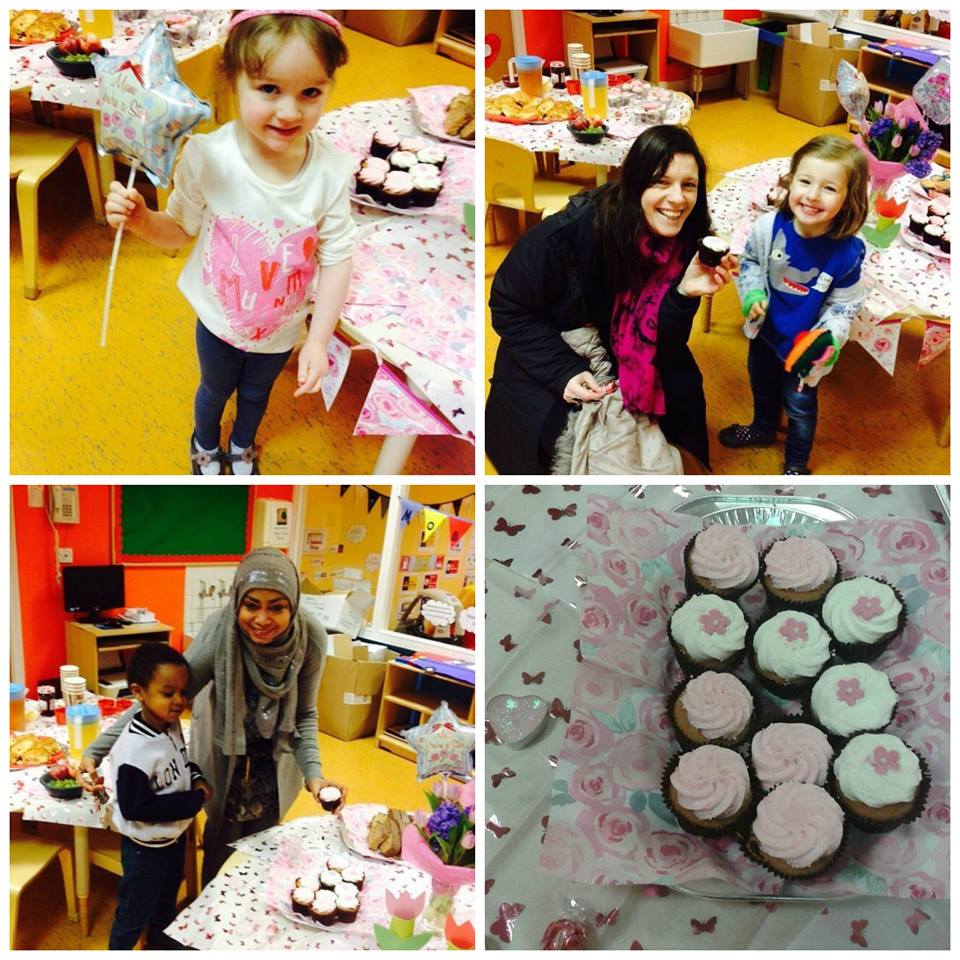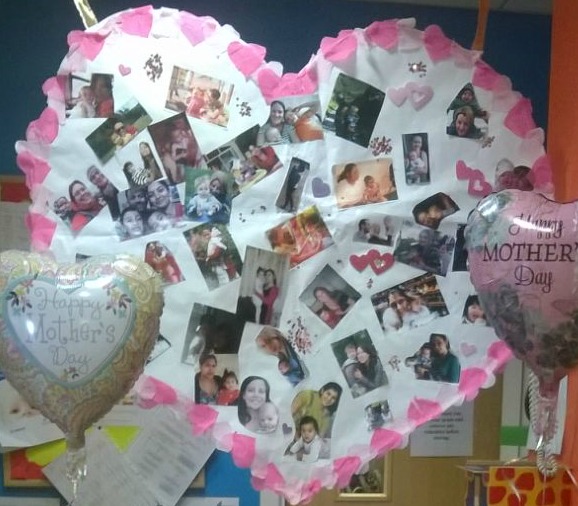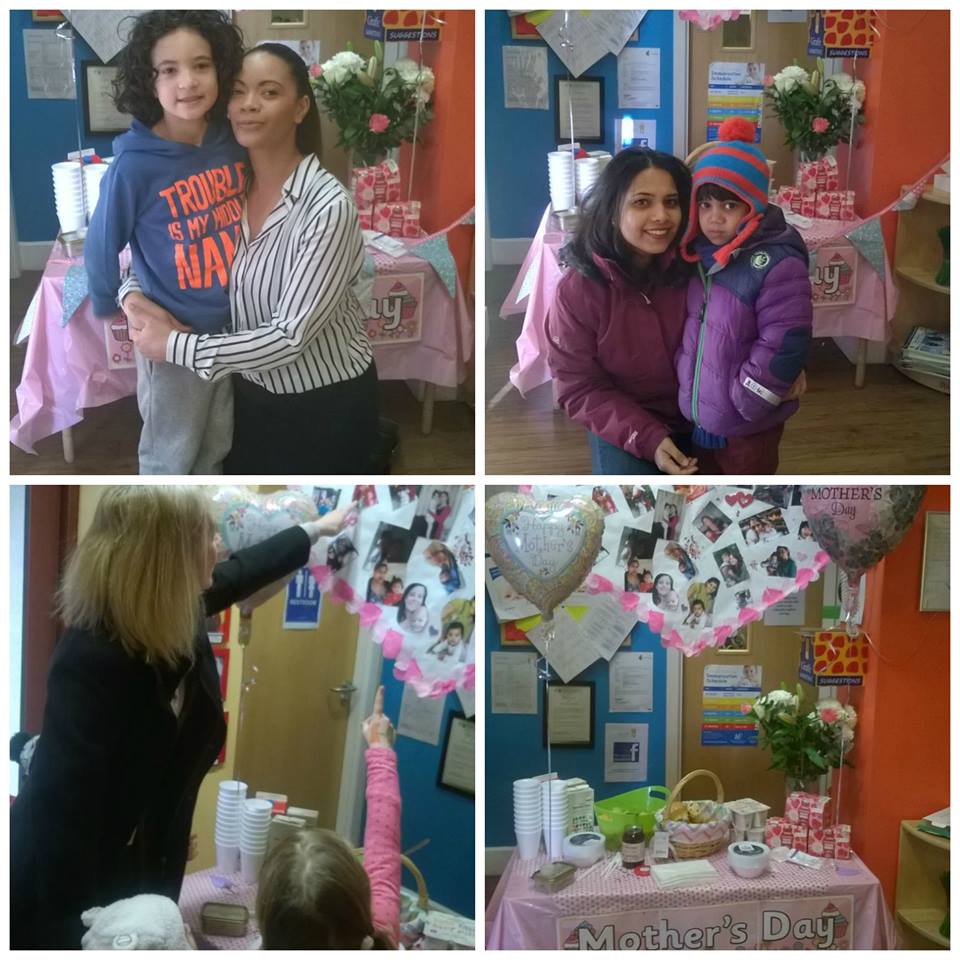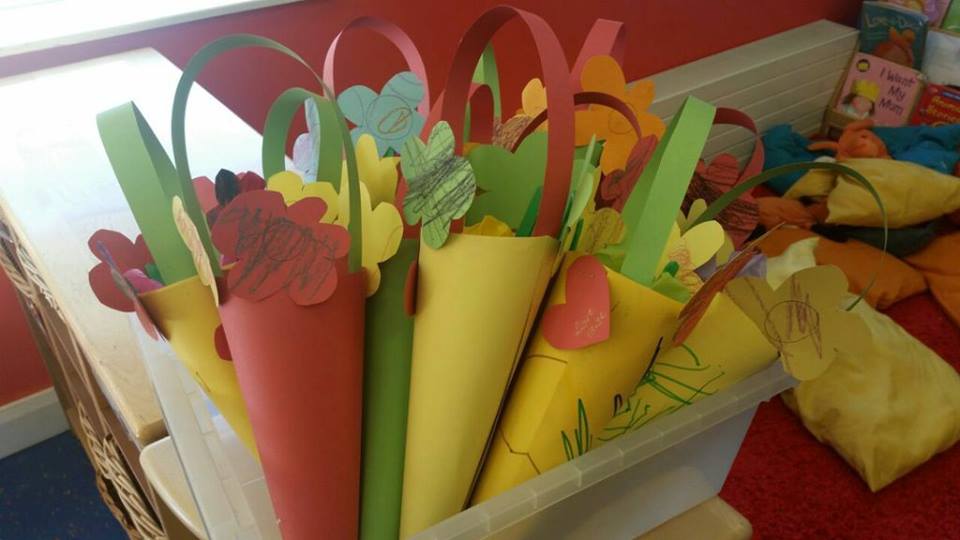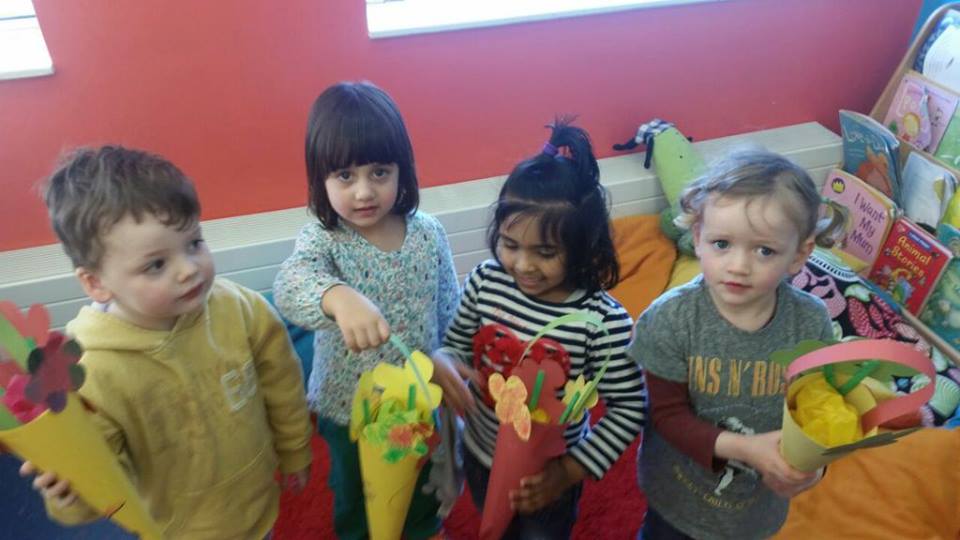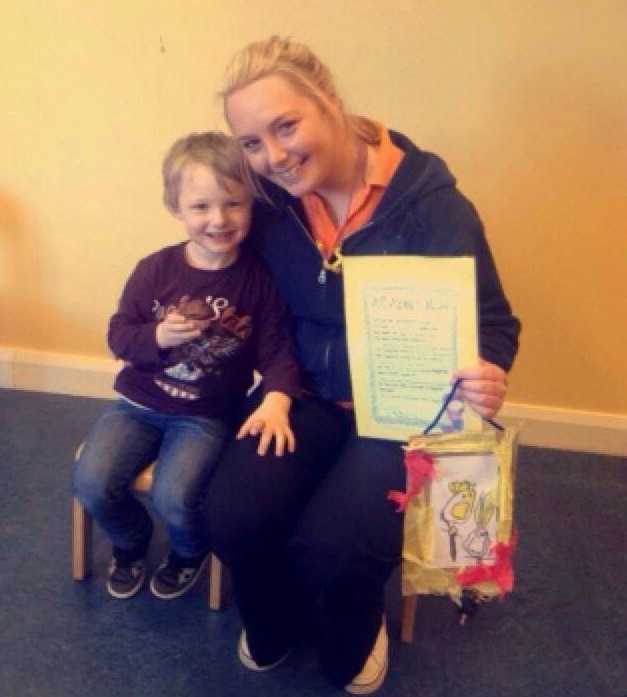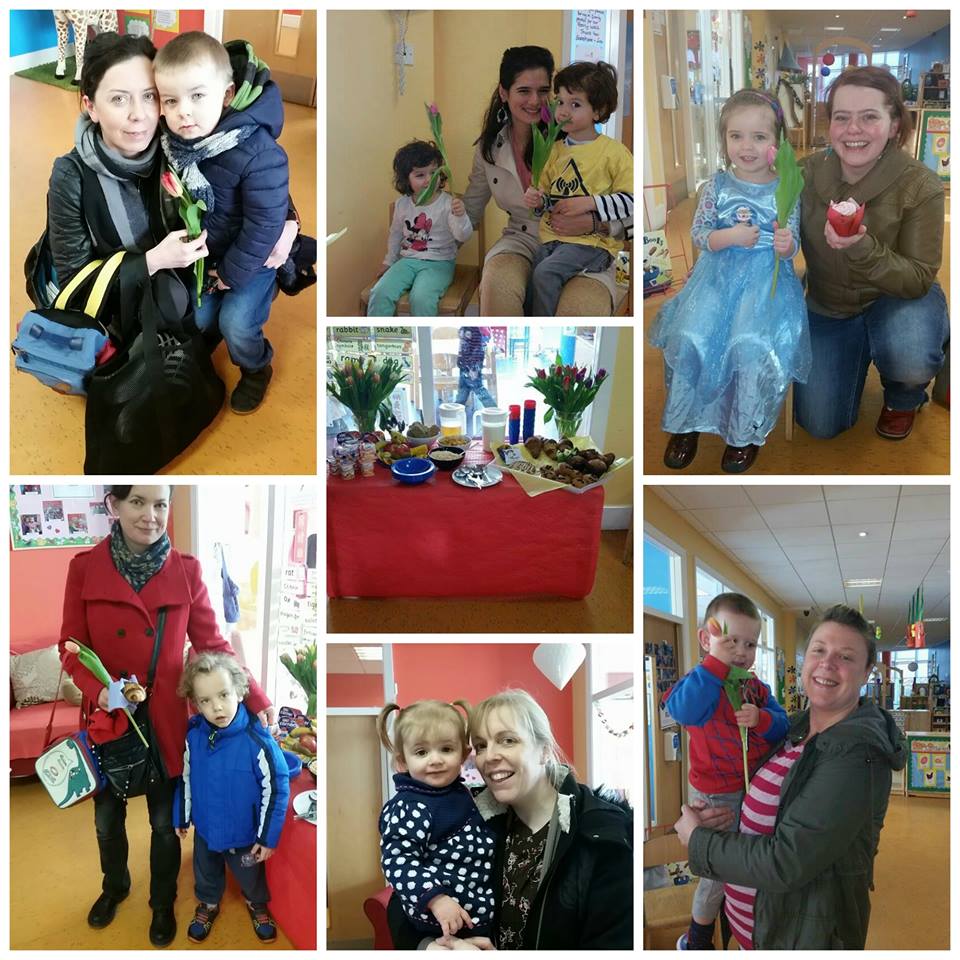A Delicious History of Chocolate

Many of us treat ourselves to a nice bit of chocolate from time to time, but what goes into that bar or Easter egg? How were today’s popular chocolate inspired? Did you ever hear of a Chocolate Potato Cake? Would you be surprised if the Irish were involved in such a recipe?
We have produced a mouth-watering timeline: The Delicious History of Chocolate, just in time for Easter! Covering 4,000 years of the tasty treat, we’ve shown the path from harvesting cocoa beans in Central America, to Christopher Columbus ignoring them during his search for gold, to the opening of chocolate theme-parks, to the recent development of chocolate stout – this fascinating timeline shows just how much time was needed to perfect each succulent bite!
If you would like to publish this timeline on your website, Simply Copy and Paste the Code below.
Children’s Favourite Christmas books
Chances are your little ones have been asking about Christmas since the beginning of October now, so why not indulge their excitement and snuggle up together for an especially festive story time? Here are Giraffe’s top five picks for some memorable seasonal tales to get you all in the mood. What your children’s favourite Christmas books?
Dinosaur Christmas
Jerry Palotta & Howard McWilliam

Perfect for little boys and girls who love dinosaurs, this is the amusing tale of Father Christmas’s prehistoric helpers. Yes, in the days before he had reindeer, a wonderful range of dinos pulled Santa’s sleigh, and here he reminisces on the advantages and disadvantages of each, from high-flying Pterosaurs to a distracted giganotosaurus. Funny and with fabulous illustrations in bold colours, this will keep your toddler highly entertained.
Father Christmas
Raymond Briggs
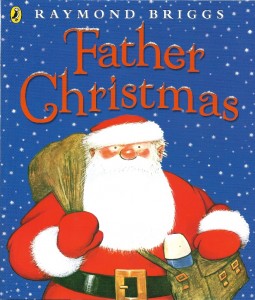
We’ve all heard of The Snowman but here is another wintry Raymond Briggs tale, this time telling of a particularly grumpy Father Christmas who is rudely awakened from a summery reverie to discover it’s already Christmas Eve and there is work to be done! A classic tale for all ages.
The Night Before Christmas
Clement Clarke Moore & Maggie Downer
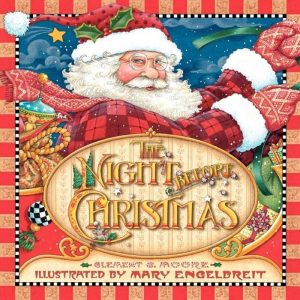
The traditional poem ’Twas the night before Christmas’ which we surely all know by heart is brought to life for toddlers here, with flaps to lift and sparkling surprises! Everything is really well thought out, with some lovely touches, from the red felt on Santa’s jacket on the book cover, to the glittering snow, holly and mistletoe throughout the book. Your little one will love opening the windows and discovering what’s hiding behind the flaps.
The Nutcracker
Susanna Davidson & Anna Luraschi
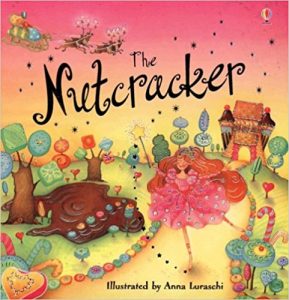
Clara’s journey into the festive Land of Sweets is made audible here, bringing Tchaikovsky’s beautiful ballet score to your little child’s fingertips with an interactive sound panel. Children will be entranced by the magical story of the Nutcracker, which comes to life on Christmas Eve, the evil Mouse King and the enchanting Sugar Plum Fairy.
The Polar Express
Chris Van Allsburg

A slightly longer tale aimed at slightly older children, The Polar Express tells the story of a boy who refuses to stop believing in Father Christmas. Boarding a mysterious steam train on Christmas Eve, he arrives at the North Pole, meets the old man himself and is offered any gift he could possibly choose. The boy’s modest selection makes for a heart-warming ending that will delight children and adults alike. In a world full of the commercialism of Christmas, this stands the test of time as a modern-day classic.
Lots of choices there to curl up and read together over the holidays. Don’t forget to read our post about Preparing for Christmas with your Child.
A History of Halloween Costumes

Add this infographic to your website by copying and pasting the following embed code:
<img src=”https://www.giraffe.ie/wp-content/uploads/2013/10/a-history-of-halloween-costumes-infographic.png” class=”img-responsive img-rounded”>
<p>History of Halloween Costumes [Infographic] An infographic by the team at <a href=”https://www.giraffe.ie/wp-content/uploads/2013/10/a-history-of-halloween-costumes-infographic.png”>Giraffe.ie</a></p>
Easy Ideas for Halloween Costumes

Halloween is just around the corner and it’s time to prepare! Whether you’re invited to a party, you’re planning on going trick or treating, or whether you’ll just be hanging out at home, kids just love to dress up for this special occasion. Here are some ideas for easy homemade costumes that won’t break the bank: (more…)
13 Weird and Wonderful Jungle Creatures
The world’s jungles are some of the richest habitats on earth, home to hundreds of species from the weird to the wonderful to the mysterious. Here are just a few of the majestic beasts who call the jungle their home.
1. Okapi
Okapi are brown with light tan or grey cheeks, throat and chest. Their upper forelegs are stripy, their lower legs have brown lined white socks to the knees and a brown band circles each leg.
It looks like a cross between a zebra and a deer. SOURCE
- Only discovered in 1901
- Elusive, not much is known about them
- Okapi mothers use infrasonic communication with their calves, which is below the range of human hearing.
- Females are slightly taller than males
- Prefer altitudes between 500 and 100 metres
[Source]
2. Proboscis Monkey
Distinguished by their prominent nose these monkeys are a brownish-yellow, with hints of grey and black.
‘Proboscis’ is a nice way of saying ‘big nose’. SOURCE
- Grow up 70cm
- Males can weigh up to 50lbs
- Only eat unripe fruit
- Males use their fleshy, pendulous noses to attract a mate
- The nose amplifies their call, impressing females and intimidating rivals
- They are prolific swimmers
[Source]
3. Green Basilisk Lizard
Bright green in colour with a black striped, whip-like tail. Males have high crests on their back and head.
This Lizard is so cool it can literally walk on water. SOURCE
- Sometimes called the Jesus Lizard because it can run on water
- Can sprint, upright, for around 15 feet at 5 feet per second across the surface
- Grow to about 2 feet (61 cm)
- Lays up to 20 eggs
- Hatchlings are born with the ability to run on land and water, climb and swim
[Source]
4. Capybara
These reddish-brown, pig -like rodents from South America have small ears, short legs and two long front teeth.
This rodent is roughly 4 times the size of an average rat. SOURCE
- Largest rodents in the world
- 3-4 feet long
- Eat their own dung
- Weighs 100-150 pounds
- Highly adapted to an aquatic lifestyle
- Can purr and bark
[Source]
5. Aye-aye
This odd looking primate has bat-like ears, rat-like teeth, one long bony finger and huge eyes.
Rabbits aren’t the only creatures that get “caught in the headlights”. SOURCE
- Feeds on insects and larvae
- Finds food by tapping on tree bark
- Taps up to 8 times a second
- Primarily nocturnal
- Sleep exclusively in the highest canopies (700m elevation)
[Source]
6. Glass Frog
Tiny and green with translucent skin on the underside, and sometimes on the top.
These tiny amphibians are as fragile as their name suggests. SOURCE
- Grows to between 1.4cm and 3cm
- Most live in the canopy of the rainforest, only coming low down to breed
- Unlike other frogs their eyes face forwards
- Their bones are visible through their skin and are green, rather than white
- There are 134 species of glass frog
[Source]
7. Sun bear
Small with short black/dark brown fur and a yellowish crest on their chest, the sun bear is a striking creature.
A bear in serious need of a manicure. SOURCE
- Grows up to 120-150cm in length
- Males weigh up to 65kg, females up to 50kg
- Smallest species of bear
- Sickle-shaped claws and long tongues are adapted to foraging termites
- Mainly feed on fruits, berries, insects
- Does not hibernate due to year round abundance of food
8. Tapir
Tapirs vaguely resemble pigs but with a short, prehensile trunk, which is actually an extended upper lip.
This Tapir is disguised as a Panda. SOURCE
- Feeds each morning and evening on aquatic plants
- Follows tunnel like paths created by many tapir to reach water holes and feeding grounds
- Spreads seeds from their food when defecating, promoting plant growth
- Excellent swimmers
- The biggest Tapir weighs 800 pounds
[Source]
9. Poison Dart Frog
Beautifully coloured frogs, depending on habitat they can be yellow, gold, copper, red, green, blue or black.
Small but deadly. SOURCE
- Tiny, around 1-2 inches in size
- Live for 3-15 years
- A group is called an ‘army’
- Only natural predator is a snake called Leimadophis epinephelus
- A 2inch long golden poison dart frog has enough venom to kill 10 grown men
[Source]
10. Tarsier
Small with huge eyes, thin tails, long fingers and extended hind limbs.
Tarsier’s always win staring matches. SOURCE
- Each eye is the same size and weight as their brain
- Longest hind limbs relative to body length of any mammal
- 18 species and subspecies
- Born with fur and eyes open, can climb within an hour of birth
- Eats mainly insects, occasionally snakes, lizards and birds
11. Mandrill
Males have orangey-yellow beards and a bright red and blue snout and rump, females and juveniles have dull blue snouts and little beards.
The most fashionable monkey around. SOURCE
- Most colourful mammals in the world
- When excited their skin colours brighten
- Live for over 46 years
- Grow up to 81cm in length with a 7cm tail
- Weigh up to 27kg
- Some groups have up 200 members
[Source]
12. Harpy Eagle
Adults have a black upper body, white and black banded undersides and a grey neck with divided crest.
This is the real גBig Bird’. SOURCE
- One of the world’s largest raptors
- Plucks monkeys and sloth out of the trees with its huge feet and talons
- Grows up to 35-40 inches in length
- Weighs up to 15.5lbs
- Hind talons can equal the size of grizzly bear claws
- Generally live below 900m but can be found up to 2000m (above sea level)
[Source]
13. Tube-nosed “Yoda” bat
They have large, rounded heads with large eyes and long, tubular nostrils extending sideways. Long grey-brown fur covers their back, their undersides are yellowish and have been likened to Yoda from Star Wars.
- Discovered in 2009
- Grow up to 80cm in length
- Weigh up to 45g
- Feed on rainforest fruits and blossoms
- Their nostrils may assist them in directional location of fruit
BONUS CREATURE “Olinguito”
With rich, red-coloured fur this member of the raccoon family has taken over a decade to identify. It’s habitat stretches from Peru to Venezuela where it can be found in ‘cloud forests’.
Don’t let its cuddly face deceive you this is a vicious carnivore. SOURCE
- Discovered in 2013
- First new carnivore to be discovered in 35 years
- 70 cm in length from nose to tail
- 35cm body and 35cm tail
- Weighs up to 900g
As the Olinguito shows there are many more weird and wonderful undiscovered creatures across the world. New and exotic species are waiting to be found in the mysterious depths of the jungle, we just need to keep searching.
Sources:
*Tube-Nose Bat photo courtesy of Piotr Naskrecki, Conservation International
Aye-aye – www.environmentalgraffiti.com
Glass Frog – www.environmentalgraffiti.com
Sun bear – www.bbc.co.uk/nature
Tapir – www.nationalgeographic.co.uk
Poison Dart frog – www.nationalgeographic.co.uk
Tarsier – www.bbc.co.uk/nature & http://www.endangeredspeciesinternational.org/tarsiersection.html
Mandrill – www.bbc.co.uk/nature
Harpy Eagle – www.worldlandtrust.org
Tube-nosed “Yoda” bat – www.nationalgeographic.co.uk & www.bbc.co.uk/nature
Proboscis monkey – www.nationalgeographic.co.uk
Green Basilisk Lizard – www.nationalgeographic.co.uk
Gardening with your child
Gardening is a wonderful activity for children of all ages. It teaches them about nature, it helps them to understand the growth cycle of all living things, and it gets them outdoors in the fresh air. If you have a garden (or even just a patio or balcony with the space for a few pots), encourage your child to join in the gardening with you.
Dig in!
Most children are naturally fascinated to discover where our food comes from. If you possibly can, involve them in every single aspect of growing vegetables; encourage your child to plant seeds and care for them, then help transfer the seedlings outside in a pot, grow bag, raised bed or vegetable patch. Let your child be responsible for regular watering as the vegetables grow, and show them how to attach climbing plants such as tomatoes to stakes to help support their weight. When the vegetables are ripe and ready, pick them with your child, prepare a dish together and eat them! Few activities offer such a full experience of the life cycle, and even if you don’t have the space to grow vegetables outside, you can always grow herbs or cress indoors.
Good vegetables to try: tomatoes, courgettes, peppers, cucumbers, carrots, and beans
- Herbs
Plant sunflowers
Sunflowers are wonderful to watch grow – observe your children’s faces light up as they realise their little tiny plant is growing far taller than they are! As their name suggests, sunflowers thrive best in full sun, after the last frosts of the winter have disappeared. They should ideally be planted against a wall for support. First let your child help prepare the soil by loosening it gently with a garden tiller. Then plant the seeds together at a depth of 1 inch – 3.5 inches, adding a little compost to improve the nutrients of the soil. After that it’s simply a case of watering regularly and watching the little shoot grow, and grow, and grow.
Plant winter bulbs
Planting bulbs in winter helps teach your child about the passing seasons and how spring brings your garden back to life. A fun Christmas time activity is to decorate a plain plant pot with stickers, foam shapes and tinsel, then plant bulbs inside. Water regularly and enjoy the first blooms of spring with hyacinths, daffodils and tulips. Outdoor bulbs could also include snowdrops, crocuses and irises.
Watch them grow!
Children will also love to watch things grow in a window box garden or maybe identify a planting area in your back garden; plant seeds and grow flowers that provide nectar and attract butterflies and insects or plant tomatoes, strawberries, peas or other fruit and veg which are easy to grow and your child will love to taste. Children will feel a strong connection to nature as they have a direct hand in its creation and have watered the plants and watched them grow. It is very rewarding to see the fruits of their endeavours and then enjoy a tasty smoothie! You may wish to be more adventurous and create a ‘wormery’ with your child which can be very simply done with an old plastic recycling box with a lid placed on bricks – drill holes in the bottom and the side, line it with newspaper so the worms don’t fall out and then add a bucket of worm bedding and soil – then you are ready to add worms! Your child will love watching the worms decompose tea bags, banana skins, vegetable peels, coffee grounds etc. but be careful not to overload the box.
Read more about the children’s activities at Giraffe Childcare.
Making reading fun
by Bryony Sutherland
Reading is an intrinsic part of our culture and a life skill your little one simply can’t afford to miss out on. Through the magic of words, kids can escape to fairy-tale castles, far-flung planets and deep dark forests. And if you can foster an early love of reading, your child won’t just benefit from the enjoyment of the stories he can then read himself, but he will also have the confidence to tackle any tasks he meets at school and beyond. (more…)
Children’s Books We Love
It’s never too early to foster a love of books with your child. Stories will teach them all they need to know about the world they live in, take them off on wonderful imaginary adventures and ultimately encourage literacy skills as they begin to read for themselves. Here are some of the children’s books we love and the children in our centres love!
0-2 year-olds
Amazing Baby: Baby Boo!
Babies learning to talk crave friendly words, repetition and plenty of clear pictures that are easy to focus on. The illustrations in Baby Boo! depict a number of babies photographed in simple black and white and juxtaposed with colourful, minimalistic text. This early board book is a visually stimulating experience for your child. Baby Boo! is a lovely, simple rhyming book celebrating babies of all dispositions with a mirror at the end for that extra surprise touch.
That’s Not My Tractor by Fiona Watt & Rachel Wells
This is but one of the hugely popular That’s Not My series, all of which use colour and texture to stimulate young minds. The simple, repetitive language ‘That’s not my tractor, its engine is too bumpy‘ is specifically designed to improve vocabulary, linking common adjectives ‘rough’, ‘scratchy’ etc. to inbuilt textures for babies to touch. Investigate the rest of the series for similar books discussing dinosaurs, teddies, princesses and many more.
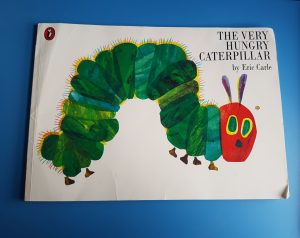 The Very Hungry Caterpillar by Eric Carle
The Very Hungry Caterpillar by Eric Carle
Few children’s bookshelves are complete without this longstanding favourite. This books has a wonderful sensorial element, with cutaway holes for little fingers to explore and colourful food to recognise and count. Toddlers will love to anticipate which foods the caterpillar will eat next. And of course his amazing metamorphosis into a beautiful butterfly! This is a timeless classic.
2-4 year-olds
Counting Colours by Roger Priddy, Robert Tainsh and Jo Rigg
Far and away the best book Giraffe ever saw on teaching the concept of colours to older babies. Your toddlers and pre-schoolers will also enjoy searching for the hidden objects and counting their findings too. There are only a few books that truly stand the test of time as children’s learning abilities develop so quickly, but there really is something for every age in here.
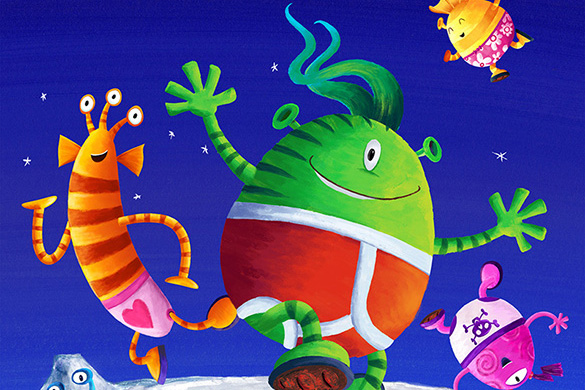 Aliens Love Underpants by Claire Freedman and Ben Cort
Aliens Love Underpants by Claire Freedman and Ben Cort
Few things induce the giggles in three-year-olds more than the subject of underpants, and this brilliantly funny book capitalises on the effect. It’s a zany tale about how aliens came to earth to steal your knickers! This is only the first in the series, which has been expanded to include the underwear of pirates and dinosaurs. A fun bedtime read.
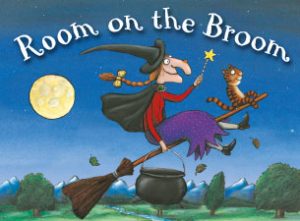 Room On The Broom by Julia Donaldson and Axel Scheffler
Room On The Broom by Julia Donaldson and Axel Scheffler
The author Julia Donaldson and illustrator Axel Scheffler deserve a special mention here, as the multi-award winning team behind The Gruffalo, The Snail And The Whale, Monkey Puzzle and many more much loved titles. In ‘Room On The Broom’, we learn the tale of how a witch and her various animal friends overcome all manner of obstacles as they fly through the air. Many of the children in giraffe know this one off by heart!
5-7 year-olds
See Inside Your Body by Katie Daynes and Colin King
This popular educational series from Usborne shows young readers what it looks like inside your body, in a fun, colourful board book. There are plenty of flaps for your child to lift and discover further information. As well as covering human anatomy there are similar titles including the topics of space, planet earth, the sea and more. Note to parents: these books make brilliant birthday presents for your children’s friends!
Winnie The Witch by Valerie Thomas and Korky Paul
Winnie is an enduring heroine who appeals equally to girls and boys. Her exploits are delightfully madcap! The illustrations are so finely drawn that it takes many, many readings to thoroughly appreciate all the hidden humorous details. Winnie The Witch is the original tale, which has now been expanded into a whole series of adventures, all of which are highly recommended. This book is almost as much fun for the parents as it is for the kids!
Don’t forget to check out our other blog post on Making Reading Fun!
What are your favourite books to read with your little ones?
Beating the winter bugs
It’s quite common for children to have regular coughs and colds as they have immature immune systems and are more susceptible to viruses to which they have not yet developed immunity. After all, it is estimated that more than 200 different viruses cause the common cold and your child can develop immunity to only one of them at a time! If you think about all the colds, we as adults have had over our lifetimes and are likely still to catch, then it is unlikely any of us will ever be immune to the common cold!
Children and the Common Cold
As your baby grows, he or she will be interested in everything around them and will naturally begin to explore their environment which involves a lot of touching and licking! Most flu and cold viruses are spread by direct contact so it is quite easy for a child to pick up a cold virus on their hands and then simply rub their eyes or put their fingers in their mouth and the virus will take hold.
On average, children under age 3 can catch up to six to eight colds a year. Because your child cannot always tell you in time when they have a runny nose and you don’t always spot it immediately, then the virus can end up on their hands, clothing, and toys and sometimes even on furniture and bedding! It is estimated that cold virus can live for approximately 30 minutes which explains how the virus can spread so quickly. When another child touches an infected toy and then rubs their nose or eyes, then they are vulnerable to catching the cold as well.
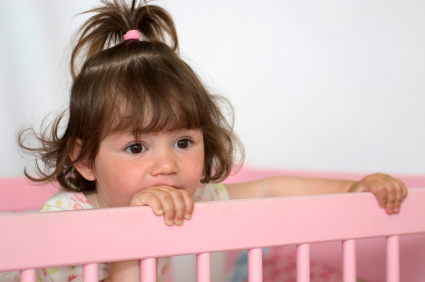
When your child is in crèche, they may be susceptible to catching more colds as they are constantly mixing with other children. Good hand-washing hygiene for all the children and the staff team at crèche is essential as it is at home for your child and all the family to minimise the spread of the cold virus.
Children also catch colds more frequently in the autumn and winter months because cold air and indoor heating dry out their nasal membranes, making it easier for a cold virus to take hold. Children also spend a lot more time inside where viruses can spread easily from person to person so it is important to ensure that children have fresh air daily and that their crèche and home environments are aired by simply opening a window and are regularly wiped down.
How should I treat my child’s cold?
No medicine will make a virus go away any faster, but you can help your child feel better and prevent the infection from getting worse by making sure your child gets plenty of rest and fluids.
Granny was right: Chicken stew contains anti-inflammatory substances that may ease cold symptoms, it’s easy to digest and helps prevent children from becoming dehydrated, it feels soothing on a sore throat, and is liked by children.
Since most children don’t master nose blowing until about age 4, here are a few ways to help ease their congestion:
- Moisten the air. Use a humidifier to keep your child’s nasal secretions more liquid or take your toddler into the bathroom with you, turn on the hot water, close the door, and sit in the steamy room for about 15 minutes. A warm bath can accomplish the same thing.
- Elevate your child’s head. Raise the head of your child’s mattress by a few inches by putting a rolled towel under the end of the mattress. Never use pillows to prop up your toddler as they create a risk of suffocation.
Catching a common cold is something that happens to us all but we can make it easier for our children by helping to manage their symptoms and letting them get plenty of rest to build up their energy. Children are generally not excluded from crèche if they have a mild head cold and a sniffle, however, if they have a high temperature, are lethargic and cranky, and generally unwell, then parents are advised to give their child some rest and TLC at home until they feel better.

Tips for preventing cold and flu this winter
- Wash your hands. Washing your hands and your child’s regularly with warm soapy water for at least 30 seconds will help protect you from germs. Or rub a hand sanitizer onto your hands. Most crèches will have sanitizers for general use and have handwashing facilities in the toilets.
- Get fresh air. Regular fresh air is important for you and your children, especially in cold weather when central heating dries out the air. During the cold weather more people stay indoors, which means more germs are circulating in crowded, dry rooms. Open the windows and air your home or wrap up well and go outdoors for a walk or to the park.
- Relax and get plenty of rest. Make sure your child gets enough sleep and rest as they will be better able to fight infection.
- Eat healthily. Encourage your child to eat plenty of fresh, healthy foods during the winter months to boost their immune system, especially dark green, red and yellow vegetables. Make smoothies and include fruit in your child’s daily diet.
- Drink plenty of fluids. Give your child plenty of fluids, especially water, so that they don’t dehydrate as their bodies will find it harder to fight infection.
- Use a tissue. Show your child how to cover their mouth and nose with a tissue when coughing or sneezing as germs and viruses cling to hands.
33 And A Third Facts About St. Patrick’s Day
Who was Maewyn Succat, and how did he go on to become Ireland’s globally-celebrated patron Saint Patrick?
We have put together an educational infographic that contains 33 (and a third!) facts about Saint Patrick’s Day, from Patrick’s own childhood on the western coast of Britain, to how both sides of the Atlantic have developed traditions to celebrate the national Irish holiday. The informative infographic is fascinating to both children and grown-ups alike, with the first ever St. Patrick’s Day parade in 1737, to Patrick’s founding of the Armagh Cathedral, and the other countries that have a connection to our own patron saint. (more…)
Heuristic play within our setting
In Giraffe we believe play is a crucial part of any child’s development. Children play because they enjoy it, and its fun! We try to make each child’s learning experience from day one in our setting as positive, fulfilled, and as imaginative as possible on a daily basis.
We carry out many different activities daily to enhance and develop each child’s development, meeting each of the five areas. The following are the five areas of a child’s development:
- Physical
- Intellectual
- Linguistic
- Emotional
- Social

In our facility we develop all learning aspects of the children’s development through our extensive curriculum and daily activities. In our baby and wobbler rooms we create a home from home experience, creating a warm, secure, friendly cosy atmosphere. We have a variety of activities from water, sand, creative and sensory play, story time, music, heuristic play and relaxation.
What is Heuristic play?
Heuristic play is a term used to refer to the kind of games that encourage active exploration through the use of children’s senses. The child instinctively seeks to investigate objects, which interest him or her, and makes discoveries via taste, touch, smell and sound.
We have a variety of colourful baskets filled with different materials, and objects to develop the baby and wobblers senses and touch. We have noisy baskets, textile basket, wooden baskets and reflective baskets. They contain some of the following items:
- Bells
- Homemade shakers
- Small musical instruments
- Sponges
- Velcro
- Scourers
- Wooden spoons
- Wooden pegs
- Old CD’s
- Teaspoons
- Hand bells
Which makes this an ideal activity that can be develop and extended from the creche setting into the family home, and all items do not have to be an expensive on the family. This also builds on our parental relationship with our families, as looking after all your precious children is our priority and we want to work in a partnership to ensure each child’s learning experience and individual needs are meet while in our centre.
Benefits of Heuristic Play:
The open-ended and exploratory experiences heuristic play provides benefits children’s cognitive, social and emotional development:
Learning how to maintain attention and focus on an activity is an important skill for children to develop; and when children are particularly fascinated and engaged by they are doing, as they are during a heuristic play session, their concentration levels are considerably higher.
Heuristic play strongly encourages children to begin to explore using trial and error methods. In this way, they learn about the properties of materials and experience, first hand, concepts such as size, shape, capacity and mobility.
It encourages older children to extend their imaginative and creative thinking and use their language skills to begin to use one object as being representative of another (e.g. pebbles as money).
One of the biggest benefits of this kind of play is the ample opportunities for independent decision making. It allows children to feel that they have the chance to control their environment and learning, and to be able play independently of adults.
Sweet Bread (Challah) Recipe for Rosh Hashanah
Last week it was Rosh Hashanah, the Jewish New Year. To celebrate it with all our children relocated from Israel, we invited Maya’s mum Efrat to come today to bake a Challah with us at our centre in Celbridge. Challah is a special Jewish braided bread. The one made for Rosh Hashanah is made with honey to wish you a sweet New Year. The children had so much fun with this activity and the end result tasted delicious. Efrat has kindly shared the recipe with us below so you can have a go at making it for yourselves at home.
Ingredients:
1 kg Plain Flour
2 Tablespoons of Dry Yeast
1 Tablespoons of Salt
¼ Cup of White Sugar (50 gr)
¼ Cup of Honey
2 Big Eggs
1/3 Cup of Oil (80 ml)
1 Cup of Lukewarm Water
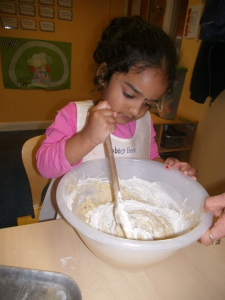
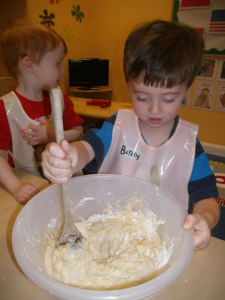
Preparation:
- Put the flour and yeast and stir.
- Add the remaining ingredients in the order listed and knead about 10 minutes until the dough is soft and a little bit sticky.
- Place the dough in a bowl covered with a towel in a warm place for about an hour and a half, until the dough doubled in size.
- Flour the work surface and a rolling pin. Roll out the dough into a rectangle, size of 20 X 50 cm.
- Make short cuts in the dough, parallel to the short sides of the rectangle. The cuts should be within 2 cm apart, and should end about 2 cm before the end of the long sides
- Roll the dough from its long edge and connect the two ends to obtain the shape of a crown.
- Carefully transfer to a baking pan lined with baking paper, brush the crown with a beaten egg and let rise for about two hours, until the dough doubled in size.
- Towards the end of swelling, preheat the oven to 180 degrees.
- Bake for 40-30 minutes, until the bread is golden.
Wishing you all Shana Tova!!! A Happy & Sweet New Year!!!
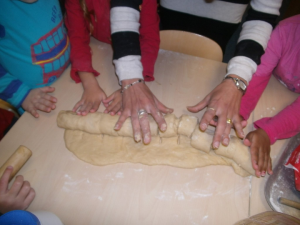
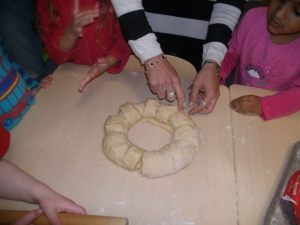
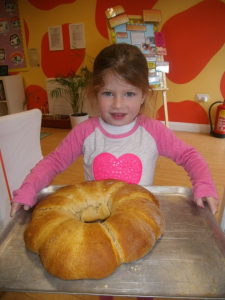
Our Managers
No day is ever the same!! You cant get bored in this job. You are always on the go, educating and caring for the children, meeting new people and dealing with the daily demands of a busy centre. I love my days off just like anybody else but to be honest, after a few days off I can’t wait to get back to the creche!
We all have our good and bad days but in here you can be cheered up within a matter of seconds. You only have to open the door of the rooms and the children are usually shouting your name, running for a hug or bidding for your attention. They are always so keen to tell you all their news which has to be told in a matter seconds and everyone has to tell you all at once. I just find them fascinating to listen to and watch while trying to figure out what goes on in their little minds.
I also love the fact that while you work in your centre with your team on a daily basis, you are also working with another 20 centres and their staff teams and everyone supports each other! I have worked in a few centres over my time and I love that when I go to another centre, I am bound to know a friendly face – Giraffe is literally like a little community.
Our Chefs
Day in the life of: Our Chefs
Food Stories
I wish I had joined earlier………….
Father’s Day – Happy Daddies and Happy Little Ones!
Father’s Day is a great chance to celebrate the Daddies and it is a lovely family day. We brought a real sense of that into the centres with many activities leading up to the day.The boys and girls in our crèches had a busy week leading up to Father’s Day preparing gifts and cards for their Dads. The preparation for Father’s day involved many Aistear themes – well being, identity and belonging and communication!
Felicity in Junior preschool in Liffey Valley had a great fun making this special card for her Dad!
Our Blanchardstown children painted lovely pictures of their Dads and told us why their Dad was the best.
Boys and girls in NCI made beautiful cards and gifts for their dads and grandads! They painted mugs with their handprints and made cute cards that said ‘I love you berry much’.
We welcomed all the Daddies for a special breakfast in each of our centres on Friday June 19th to celebrate Father’s Day. They could drop in and stay for a sit down breakfast, or we even had a ‘breakfast on the go’ option for those in a hurry. We had great smiles all around from both the Daddies and the little ones as the children loved having their Daddies with them in the crèche for a while that morning.
Here is Anna and her Daddy Paul at the Father’s Day Breakfast in Celbridge.
The Dads in Stepaside were treated to a lovely sit down breakfast with their children.
Giraffe Harcourt Road had a splendid breakfast laid out for the Dads. Here are some of our children with their Daddies on the day!
Some very happy Dad’s with their children having breakfast in Giraffe Leopardstown.
We asked many of the children in the centres what do they love about their Dads. We got some wonderful, clever and super cute responses.
I love my daddy because he brings me to funky monkeys – Ethan (4)
I love my daddy because he gives me a kiss when he goes to work- Shauna (4)
I love my daddy because he reads me stories at bedtime – Louise (4)
“I love my daddy because he brings me for a cycle” – Seán (3)
“I love my daddy because he’s bringing me on holidays” – Olivier (3)
“I love my daddy because he does everything for me” – Noah (3)
Macie aged 2 (pictured below) says “I love my daddy because he says whoosha on the see-saw”
You can see from all the happy faces that the children (and the Dads) really enjoyed all the Father’s Day activities and a great time was had by all.
Preparing you & your child for school
Starting school is an exciting time for you and your child and you’ll naturally want to help them to best prepare for the adventure ahead. While it may be normal for you to feel a little nervous about your child starting school, remember that they’ll pick up on your emotions and take your lead, so it’s important that you’re relaxed and feeling positive about the change.
Prepare in advance
Remember also that your child doesn’t need to be able to read, write or do sums before starting school. Children start school with a wide range of abilities, and their teacher will be used to this. What’s most important in those special preschool months and years is that you and your child have fun when you’re together. All of those hours sharing stories, singing songs, playing games, chatting and encouraging them, helps to build their confidence.
Here are some tips to help you prepare your child for starting school so that you both start school with a smile!
Chat with your child about starting school. What do they think it will be like? What are they most looking forward to? Is there anything they’re unsure or worried about? Look at the school’s prospectus or the website together and talk about the pictures.
Find photos of you and other family members at school, and chat about happy memories from your own school days. If possible, visit the school with your child before they start – either on formal open days, or fêtes, plays and other events.
And some things to avoid…..
Try not to overload your child with endless talk about school – treating it in a matter-of-fact way rather than focusing on the ‘big step ahead’ will help soothe an anxious child. Don’t over-hype school as your little one may feel let down or upset if it doesn’t live up to expectations, find a balance that feels right to you.
At Giraffe we help prepare children for school. By reading storybooks about starting school and introducing lunchbox Wednesdays in the summer term, children become familiar with the idea of school and packed lunches. In our book corner, we keep a scrap book of pictures of ‘big’ school and there are also a couple of school uniforms in the dressing up area so that children are familiar with them. Read more about our Preschool Graduations.
- Griffeen Graduation
- Graduation Northern Cross
- Graduation!
Promoting your child’s independence in toileting in preparation for school is also important. Working alongside your approach at home, at giraffe we help children become confident about getting to the loo in time, wiping properly, using toilet paper rather than wipes, flushing the toilet and washing their hands. You can also remind your child to ask the teacher if they need the toilet and reassure them that it’s ok if they don’t get there in time. Remember to pack some spare underwear and clothes as well, accidents will happen.
If your child has already spent time in a crèche or pre-school setting, they’ll be used to spending time apart from you, mixing with other children, communicating with other adults and taking some responsibility for tidying up after themselves and looking after their own belongings. But don’t worry if your child hasn’t attended a childcare setting or pre-school. Playing with other children, whether friends and family members, or other children at the park, comes naturally and is good practice for forming friendships with classmates at school.
Children that don’t know one another will usually make friends very easily. If your child does struggle with the change however, teach them some useful phrases such as ‘can I play with you or can I join in? or ‘do you want to share?’ If you already know some other children who will be in your child’s class, organise a play date or outing together before the start of the school term.
Get to know their teacher
It’s also a good idea to establish an open, friendly relationship with your child’s class teacher, ask them when you first meet what are their preferred times and means of communication. Your childs teacher will be an expert at helping young children to settle in and thrive at school, and will be able to reassure you about most issues that come up. If you do have any concerns, raise them early to prevent them from developing into bigger problems.
If there’s anything you think might help your child to feel settled, be sure to suggest it to their class teacher. Remember, you know your own child best.
Supporting a clingy child
Some tips to help with a child who is clingy
As adults and parents, we sometimes need to remind ourselves that clinginess is a natural reaction to feeling anxious or fretful about something, particularly if there have been some changes in your child’s life. In young children, clinginess is a normal response to feelings of anxiety or upset and can brought on by normal life changes such as a new baby, changes in routine or any number of new situations. The good news is it’s just a phase and there’s lots you can do to put your little one at ease and help them to move on.
Don’t ignore or overly discourage their clinginess. When young children exhibit clingy behaviour, view it as a positive sign that your child feels secure with you and seeks you out for comfort when they are upset or distressed
Praise your child for tasks or activities that they are able to do independently. Like helping to tidy up, finding their wellies or playing nicely on their own or with their friends. Praising your child for doing things independently helps them be confident without your constant close supervision and guidance
Increase social activities and arrange special playtime. Socialising with children of the same age will help children develop attachments to their peers and can build social skills necessary for interacting with people outside of the immediate family. Set up regular play dates (crèche is a great resource here) or schedule a fun day out or weekly trips to the local park
Stay with your child during social activities. Play with your child and their friends until they are comfortable playing on their own. Be available during play dates to teach and model social skills, respond to conflict, and monitor situations that may cause stress or anxiety
Use a consistent phrase when saying goodbye. Be brief, do not linger, and do not overreact if your child gets upset after saying goodbye. Overreacting will only feed into your child’s anxiety and make it worse, while lingering will increase the likelihood that your child will continue to cry or seek your affection to prolong your stay each time
Finally, remember, periodic clinginess is normal, and it’s actually a sign that you and your child have a healthy relationship.
Why are nursery rhymes useful in the lives of young children today?
Young children just cannot get enough of Nursery Rhymes
(more…)
After School
Selected Giraffe settings provide an additional after school childcare service for children up to twelve years old (based on demand). The service is flexible and can be structured around your changing needs. We are happy to provide your child with a nutritious breakfast, drop your child to school and also collect them at the end of their day with a friendly face.
Your child can complete their homework and unwind with a broad range of exciting and challenging activities including Cookery, Arts & Crafts, Games, Music, Dance, Computers as well as mixing with their friends or siblings.
This service is available all year round, closing only at week-ends and on public holidays.
Please contact us on (01) 2450935 to enquire further about this service.
Mother’s Day Breakfasts – Flowers, Cakes and Happy Smiles
Mother’s Day takes on a whole new meaning when you have children yourself; any cynicism about made-up, commercial occasions is displaced, once you get that first homemade card or toddler-produced breakfast in bed. Even if said toddler usually eats most of it!
So it’s not surprising to see such happy smiles in our gorgeous series of photographs below – all taken on Friday March 13th, at our Mother’s Day breakfasts.
In Giraffe Lucan, there was a very pretty display of cakes to welcome mothers, and huge smiles from the children who surprised them.
In Giraffe Adamstown, as well as breakfast, there was a lovely heart-shaped display, featuring photos of the children with their mothers.
The children loved pointing out their own photos to their mothers, and everyone enjoyed the delicious treats – of course!
In Giraffe Rathbourne, children surprised their mothers with beautiful, colourful bouquets of flowers that they made themselves:
Here you can see pre-schoolers from the Zambia room in Rathbourne with the finished work, didn’t they do well!
In Giraffe Cherrywood, our carer Emma had a wonderful surprise when her little boy Matthew presented her with gifts he had made for her. Look at the lovely smiles!
In Giraffe IFSC, we had a beautiful, bright breakfast table with fresh tulips and daffodils, which were then presented to the mums. There were colourful balloons, and a very tempting array of cakes and treats. What a lovely way to start the day – the photos of mums and children below tell it all.
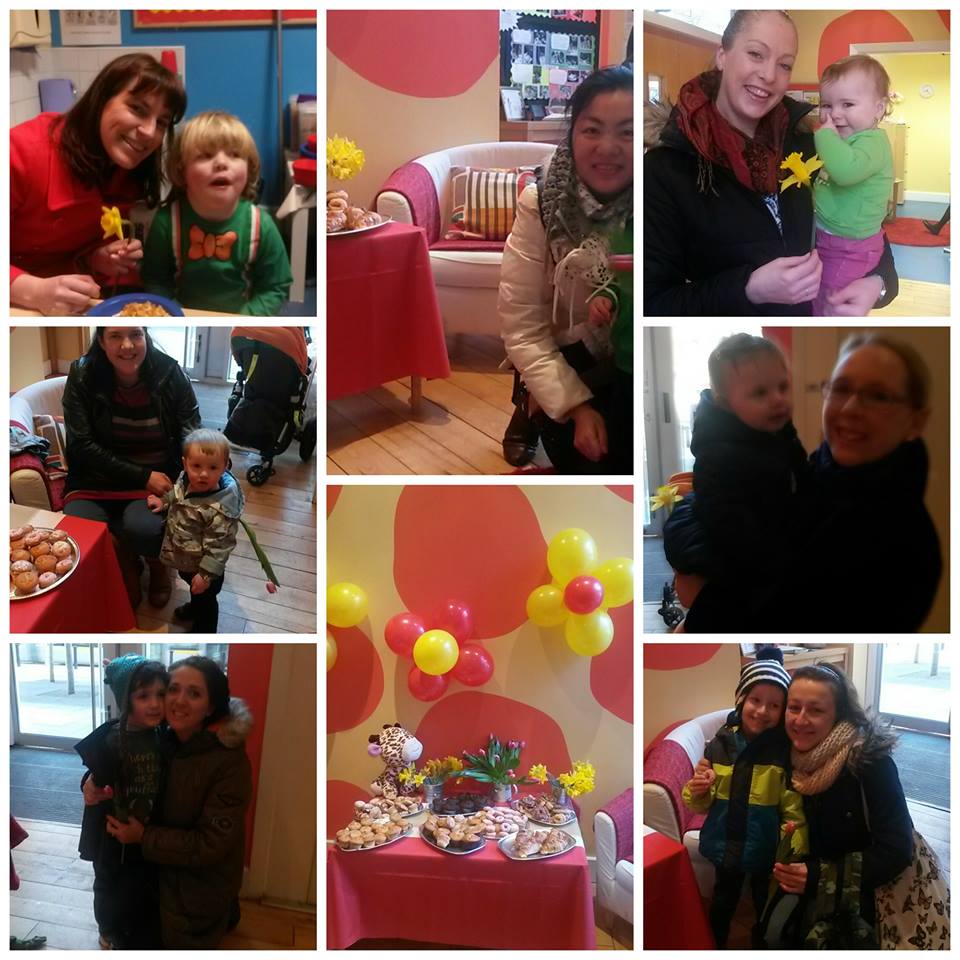 Flowers and cakes from our favourite people – no wonder everyone is smiling!
Flowers and cakes from our favourite people – no wonder everyone is smiling!
And all the mums in Giraffe Park West were greeted with breakfast and a flower too – again presented by their children.
Gorgeous photos of happy mums and delighted children!
Because of course, when you’re a parent of a small child, that’s what Mother’s Day is really about, the excitement on small faces as they present a card or a flower or even just a hug. And actually, that might just be the best gift of all.














